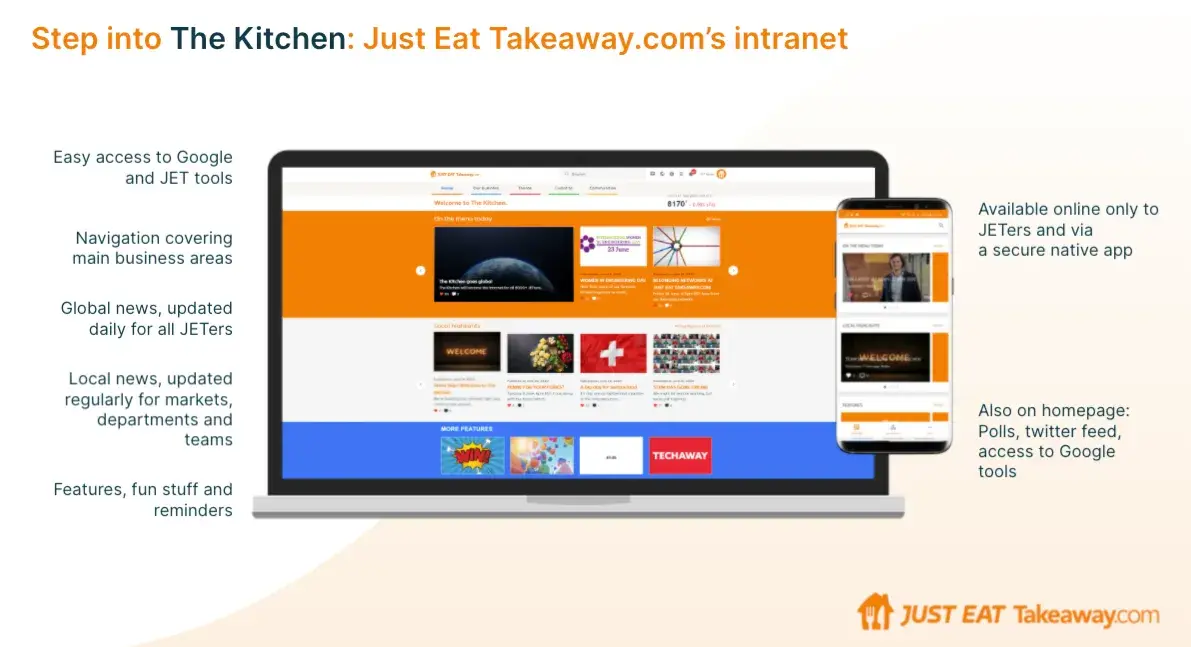How to Master Mergers & Acquisition Communication with an Intranet


Mergers and acquisitions are complex, with many moving parts. They bring together different cultures, operations, and people. Success often comes down to one critical element: communication. A strategic M&A communication plan is the key to building trust, easing anxiety, and guiding everyone toward a shared vision.
Without clear and consistent messaging, you risk confusion, low morale, and talent loss. Technology, especially a modern intranet, is your best asset for keeping everyone connected and informed. It acts as the central nervous system for your new, combined organization.
This guide will explore how a thoughtful communication strategy, powered by the right technology, can create a smooth transition and set the stage for long-term success.
The Importance of Communication in M&A
The period following a merger announcement is filled with uncertainty. Employees naturally have questions about their job security, roles, and the company's future. A lack of information creates a vacuum that rumors and fear will quickly fill.
This is where your communication strategy shines. Proactive, transparent, and empathetic messaging can address concerns head-on, reduce stress, and build trust. When employees feel respected and informed, they can focus on their work instead of worrying about "what if" scenarios. Strong communication is also vital for retaining your top talent. By clearly explaining the vision behind the merger and how each person fits into that future, you make a compelling case for them to stay and contribute.
A Phased M&A Communication Strategy
A merger is a journey, not a single event. Your communication plan should reflect this with a phased approach that provides the right information at the right time.
Phase 1: Design and Ramp-Up
This initial stage is confidential, where leaders formulate plans and set goals. Your intranet is the perfect place to create a private, secure community for key stakeholders. This space allows leaders to collaborate, establish milestones, and lay the groundwork for the entire process.
Phase 2: Announcement
This is the moment the news goes public. Your announcement should be a clear, well-articulated plan that kicks off the formal process. Use your intranet to create a space for two-way dialogue where employees can ask questions and express concerns. This openness helps maintain morale and prevents turnover.

Phase 3: Pre-Close Integration Planning
After the announcement, don't let communication go quiet. Employees are eager for information as it becomes available. Create dedicated communities on your intranet for steering committees or cross-departmental groups. This keeps key players informed and allows them to provide input as the integration moves forward.
Phase 4: Day 1
Day 1 is a culmination of all the planning. It’s a day for celebration and building momentum. Use the intranet to connect team members and celebrate the news. These interactions help build excitement for the future and the work of restructuring the new organization.
Phase 5: Integration Implementation
This final phase is the longest and involves the real work of bringing two companies together. Communication shifts from planning to belonging. Create an onboarding hub on your intranet with resources about the new company. You can use features like video learning flows or automated email journeys to welcome new team members and provide essential information.
3 Communication Tactics for Mergers and Acquisitions
1. Clear, Concise and Consistent
It’s no secret that successful mergers and acquisitions require communication. Internal communication professionals should deliver:
- Clear messaging without fluff
- Concise language with bullet points and digestible paragraphs
- Consistent debriefs with timelines and milestones
Honest and direct communication is the only way to keep employees engaged and involved in the process.
Some firms tend to be shy on communication because change is unsettling, and the answers aren’t always easy or available. Instead, embrace the facts. Employees will accept ambiguous info if they’re able to ask questions. Employees don’t need all the answers all the time, just an environment that encourages dialogue.
2. Tell the story
Mergers and acquisitions require a change management strategy. People are more comfortable with change when they know the why behind it. Furthermore, the first collective question will be, how will I be affected? Companies have a responsibility to put their workforce in the best position to succeed, or at the very least, keep them informed.
According to research by McKinsey, this is a crucial part of your announcement phase to ensure employees understand the strategy and vision behind the merger. Effective communication is crucial during the initial stages of a merger.
By clearly articulating the strategic rationale, organizations can extend the merger's honeymoon period and ensure consistent messaging to employees, vendors, and other stakeholders.
3. Internal Involvement
Speaking of employee involvement, this category carries weight on its own. Identifying internal change champions, managers, and employees, facilitates successful change management through communication. These groups spread the narrative throughout the company and drive two-way communication.
A lack of internal involvement can lead to turnover. When Sprint acquired a majority stake in Nextel Communications for $35 billion in stock options, they were set to become the third-largest telecommunications provider. But Nextel executives and mid-level managers left in droves, citing company culture differences. Nextel employees were left out of decisions, and faced lengthy approval processes through Sprint executives. Three years later, Sprint Nextel posted a $29.5B quarterly loss and the stock received a junk status rating.
How an Intranet Can Help in Mergers
Intranet platforms are crucial for effective communication within a company. They help address employee concerns and set the stage for future success.
The perfect intranet doesn’t just meet your needs—it anticipates them, especially during the complexities of mergers and acquisitions. It’s a smarter intranet that adapts to how you work, ensuring a seamless transition across all fronts.
Centralizing Employee Communication to Ease Transitions
During M&A, rumors can spread quickly. An intranet serves as the definitive, central repository for all official information, dispelling misinformation and ensuring everyone receives accurate updates.
An intranet acts as a lighthouse serving as the single source of truth during waves of confusion. This centralized location helps organize company wide information, ensuring that employees are on the same page.
Following uses can help :
- Centralized News Hub: Publish timely announcements, official statements, and important updates in a dedicated section. This becomes the go-to place for employees from both entities.
- FAQs and Q&A Sections: Anticipate employee questions about job security, roles, benefits, and culture. A comprehensive, regularly updated FAQ section, along with a mechanism for employees to submit questions (even anonymously), builds trust and transparency.
- Leadership Messages: Share direct messages, videos, and articles from leadership to convey vision, address concerns, and foster a sense of unity. This personal touch is crucial in uncertain times.
For instance, in the case of Just Eat Takeaway.com, their new intranet platform was central to overcoming communication hurdles. The intranet was a shared space for employees from both companies to access merger-specific information, updates, and corporate news. This helped ensure that everyone was on the same page and well-informed.
Just Eat Takeaway's intranet helped break down information silos and cultural barriers. It fostered open dialogues and created connection points. It also encouraged employees to engage, share, and collaborate with new colleagues.
Easing Tensions from Combining Company Culture, Processes, and Resources
From HR protocols to IT systems, intranets act as a conduit in harmonizing operations post-merger. They can help smooth the transition by serving as a hub to find updated policies, training, and company resources.
For example, Stellantis was formed through a merger between Fiat Chrysler Automobiles and Peugeot. They utilized their Lumpps intranet to create a community and enhance communication within their workforce. This helped employees connect with each other and share information more effectively.
Stellantis utilized their intranet as a unified communication hub to share company information, create community, and emphasize engagement and peer-to-peer interaction. Read about the best practices learned from Stellantis.
Fostering Connection and Collaboration
M&A often involves integrating different cultures and work styles. An intranet can bridge these gaps, creating a cohesive new environment.
- Employee Directory: A comprehensive directory with profiles, skills, and contact information helps employees from both companies connect and understand the new organizational structure.
- Social Features: Forums, communities, and internal social feeds allow employees to interact, share ideas, and build relationships across former company lines. This "virtual water cooler" helps break down silos and integrate cultures.
- Cross-Functional Project Spaces: Create dedicated collaboration spaces for integration teams and new cross-functional groups. This facilitates shared document management, task tracking, and seamless communication for critical projects.
Onboarding and Integration Support
The intranet plays a crucial role in integrating new employees and harmonizing operations.
- Onboarding Hubs: Provide a dedicated space for new employees with essential information on company policies, procedures, benefits, and the new organizational structure.
- Knowledge Base: Centralize important documents, training materials, and operational guidelines, ensuring everyone has access to the information needed to perform their roles effectively in the new environment.
- Training and Development Resources: Offer microlearning modules, videos, and other resources to help employees understand new systems, processes, and the combined company's vision and values.
Maintaining Transparency and Engagement
A successful M&A relies on engaged employees who understand the "why" behind the changes.
- Transparent Timelines: Share a clear timeline of the integration process, outlining key milestones and what employees can expect at each stage.
- Feedback Mechanisms: Implement surveys, polls, and feedback forms to gauge employee sentiment, gather input, and demonstrate that their voices are valued. This helps address concerns proactively.
- Recognition and Celebration: Use the intranet to highlight successes, celebrate milestones, and recognize employees who are embracing the changes and contributing to the integration. This reinforces a positive atmosphere.
Avoid customer attrition
While an intranet's primary role is internal, its strategic use during M&A profoundly impacts external perceptions, ultimately helping to avoid customer attrition. Customer confidence is directly linked to the stability and effectiveness of the company serving them. When employees are informed, aligned, and confident, they project that stability to customers, fostering loyalty during uncertain times.
Leveraging Intranets for M&A Success
A modern intranet is more than just a communication tool; it’s a connected employee hub that adapts to how you work. During a merger, it becomes indispensable for centralizing information, fostering collaboration, and blending cultures.
A Single Source of Truth
During an M&A, rumors can spread like wildfire. An intranet serves as the single source of truth for all official information.
- Centralized News Hub: Publish official announcements and updates in a dedicated section that becomes the go-to resource for all employees.
- FAQs and Q&A: Create a comprehensive, regularly updated FAQ section to address common questions about job security, benefits, and culture. Allow employees to submit questions, even anonymously, to build trust.
- Leadership Messages: Share videos and articles directly from leaders to convey the vision and address concerns with a personal touch.
Bridging Cultures and Fostering Connection
An intranet can bridge the cultural gaps that often exist between two merging companies, creating a cohesive new environment.
- Employee Directory: A complete directory with profiles and skills helps employees from both sides connect and understand the new organizational structure.
- Social Features: Use forums and communities to create "virtual water coolers" where employees can interact, share ideas, and build relationships across former company lines.
- Collaboration Spaces: Create dedicated project spaces for integration teams to share documents, track tasks, and communicate seamlessly on critical projects.
Onboarding and Integration Support
The intranet is crucial for integrating new employees and harmonizing operations. A dedicated onboarding hub can provide new team members with everything they need, from company policies and benefits information to training materials on new systems and processes.
Intranet Features that Support Mergers
It's not enough to have an intranet; it's about having the right intranet.
One size doesn’t fit all, especially in the context of mergers. An intranet must offer flexibility in communication channels to fit the diverse requirements of teams within the organization. It provides a tailored experience that respects the individuality of departments while reinforcing the unity of the larger entity.
Feature #1: Customizable Communication Channels for Different Teams and Departments
LumApps excels in fostering community spirit within an organization, particularly through its community spaces feature where employees can connect, share, and collaborate. These "virtual water coolers" allow employees to gather in groups based on common interests, hobbies, or professional development themes. Whether it's a book club, a group for pet enthusiasts, or a wellness community, these spaces improve employee interaction and a sense of belonging.
You can also use community groups to help new employees begin to make connections. Plus, you can use the community group function to introduce news teams to their working groups. Plus, this sense of community will contribute to breaking down silos and encouraging innovation.
Feature #2: Collaboration Tools to Foster Team Integration
An intranet helps employees from different companies work together on projects and collaborate in an online space. With real-time communication and file sharing, teams can work together seamlessly, regardless of their physical location.
Feature #3: Knowledge Bases for Sharing Important Documents and Updates
A merger requires lots of information and updates pouring in from various corners. But an intranet can serve as a knowledge base to pull it all together.
An intranet is a place to build a knowledge sharing culture. Employees can access resources from other teams or departments quickly and easily, leading to a more informed workforce overall. Plus, an intranet helps resolve confusion since it houses updates, timelines, and information about the new company's vision.
Feature #4: Microlearning and Video Announcements
In the intricate dance of merger communications, video announcements can be a profoundly effective tool. Some topics are easier to explain through videos, which can simplify complex information with empathy, clarity, and a personal touch.
Video is a powerful tool for leaders to directly convey sincerity and vision. Another way to use video during mergers? Try microlearning to help employees learn about the new company's product, mission, and vision.
Microlearning involves delivering short learning modules that employees can consume in a matter of minutes. Short training videos are helpful for employees who are constantly on the go and have limited time for training. Employees can easily fit training into their busy schedules because of this flexibility to listen to the videos on the go. This makes it easier for them to incorporate training into their daily routine.
The LumApps Learning feature is an interesting solution to help employees learn about the new employees, and nuances of the new company culture, values, and procedures. This approach helps streamline the onboarding process so employees quickly become familiar with the new product or team culture.
Other considerations for the use of an intranet during M&As :
- Mobile Accessibility: Ensure the intranet is accessible on mobile devices, allowing all employees, including frontline and remote workers, to stay informed regardless of their location.
- Targeted Communication: Leverage audience segmentation features to deliver relevant information to specific groups or departments, avoiding information overload.
- Analytics: Utilize analytics to track engagement, identify popular content, and understand how employees are interacting with the information. This data helps refine communication strategies.
- Integration with Other Tools: Seamlessly integrate with other essential business tools like Microsoft 365, Slack, or HR systems to create a unified digital workplace experience.
By acting as a connected employee hub, LumApps enables organizations to navigate the complexities of M&A with clarity and confidence, building a brighter, more connected way to work for everyone. The future-ready intranet adapts and grows with you, ensuring your workplace is unique—and your solutions are too.
Case Study: Just Eat Takeaway.com

Just Eat Takeaway.com was formed through a merger of two leading food delivery companies. The merger brought over 8,000 employees together under one digital roof. Their intranet, "The Kitchen," powered by LumApps, played a vital role in their success.
The two companies had different communication styles and no central point for messaging. The Kitchen became the shared space for employees from both organizations to access merger-specific information and company news. This broke down information silos, eased fears, and fostered open dialogue. A few months after the merger, 83% of employees were active users of the intranet, and 75% felt involved and connected with the company.
A Brighter, More Connected Future
Successfully navigating a merger and acquisition hinges on a robust internal communication strategy. It’s about more than just sharing information; it’s about building a unified culture and maintaining business continuity. By combining a clear, phased communication plan with a powerful intranet, you can transform the M&A journey from a period of uncertainty into an opportunity for growth and connection.
A future-ready intranet adapts to your needs, ensuring your new, combined organization has the tools to build a brighter, more connected way to work.




